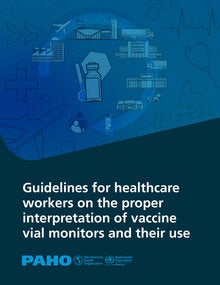To remain safe and effective, vaccines must be kept at the right temperature, but if they become damaged by heat or cold, they do not show any visible signs. The vaccine vial monitor (VVM) informs the healthcare worker if the vaccine vial has been exposed to high temperatures or not. The VVM is a heat indicator that is triggered by a temperature rise above a specified threshold. Therefore, any change in the color of the VVM indicates that the vaccine vial has been exposed to high temperatures for undetermined amount of time. This guideline has been prepared to provide healthcare workers with information on the different types of VVM that are attached to vaccine vials and on how to interpret the rate of the color change. The Pan American Health Organization (PAHO) has not issued a statement on the use of VVMs. Therefore, all immunization programs and healthcare workers should continue to follow the national guidelines/norms on the use of continuous temperature monitoring devices for the proper handling, storage, and distribution of vaccines. VVMs may provide information on whether vaccine vials have suffered heat exposure where there is no temperature monitoring device (TMD). There are five different types of VVM designed for different types of vaccine, depending on the heat stability of the vaccine. The heat stability of a vaccine is dependent on how fast (the rate) a vaccine will lose its potency when exposed to ambient temperature. For classifying the heat stability of a vaccine, three temperature classes are used – 37 °C, 25 °C, or 5 °C – for assigning the length of time it will take for each VVM to reach its end point, when the square matches the dark color of the reference circle. Consequently, given the specific heat stability for a vaccine, as measured by the reaction rate in the change in the color of the VVM over time, each vaccine is assigned a specific VVM type.
|

